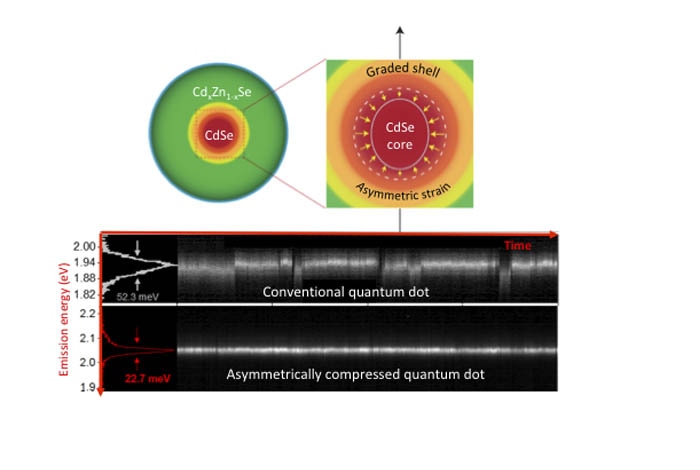Jan 11 2019
Deliberate “squashing” of colloidal quantum dots when a chemical synthesis is in progress could lead to the creation of dots with the capability of stable, “blink-free” light emission that is on par with the light generated by dots formed using highly complex processes.
 (Image credit: Los Alamos National Laboratory)
(Image credit: Los Alamos National Laboratory)
The light emitted by the squashed dots is spectrally narrow with a non-fluctuating emission energy and a highly stable intensity. According to a new study at Los Alamos National Laboratory, the strained colloidal quantum dots are a practicable alternative to the nanoscale light sources that are currently being used, and they warrant investigation as single-particle, nanoscale light sources for optical “quantum” circuits, medical diagnostics, and ultrasensitive sensors.
In addition to exhibiting greatly improved performance over traditional produced quantum dots, these new strained dots could offer unprecedented flexibility in manipulating their emission color, in combination with the unusually narrow, ‘subthermal’ linewidth. The squashed dots also show compatibility with virtually any substrate or embedding medium as well as various chemical and biological environments.
Victor Klimov, Project Lead Researcher, Los Alamos National Laboratory.
The innovative colloidal processing methods enable virtually perfect quantum-dot emitters to be prepared using almost 100% emission quantum yields demonstrated for a broad array of visible, infrared, and ultraviolet wavelengths. These developments have been used in a range of light-emission technologies, leading to successful commercialization of quantum-dot displays and TV sets.
The next step is the investigation of the use of colloidal quantum dots as single-particle, nanoscale light sources. Future “single-dot” technologies such as these would need particles that have highly stable, nonfluctuating spectral properties. The recent years have evidenced substantial advancement in avoiding random variations in emission intensity by shielding a small emitting core using a specifically thick outer layer. However, these thick-shell structures still present strong fluctuations in emission spectra.
In a new paper published in the Nature Materials journal, scientists at the Los Alamos National Laboratory showed that it is possible to almost completely suppress spectral fluctuations in single-dot emission by using an innovative technique of “strain engineering.” The most important factor in this strategy is combining two semiconductors that have directionally asymmetric lattice mismatch in a core/shell motif, resulting in anisotropic compression of the emitting core.
This alters the structures of a quantum dot’s electronic states, thus modifying its light-emitting properties. One significance of these modifications is the achievement of the regime of local charge neutrality of the emitting “exciton” state, which considerably minimizes its coupling to lattice vibrations and fluctuating electrostatic environment, which is vital in curbing fluctuations in the emitted spectrum. An additional advantage of the altered electronic structures is the drastic narrowing of the emission linewidth, which turns smaller compared to the room-temperature thermal energy.